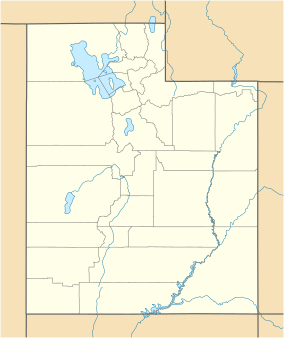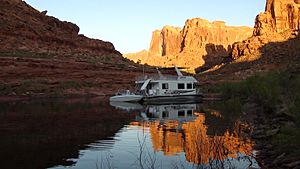Glen Canyon National Recreation Area facts for kids
Quick facts for kids Glen Canyon National Recreation Area |
|
|---|---|

Reflection Canyon
|
|
| Location | Kane, San Juan, Garfield, and Wayne counties, Utah & Coconino County, Arizona, United States |
| Nearest city | Page, Arizona, Bullfrog, Utah |
| Area | 1,254,117 acres (5,075.23 km2) |
| Established | October 27, 1972 |
| Visitors | 5,206,934 (in 2023) |
| Governing body | National Park Service, Bureau of Reclamation |
| Website | Glen Canyon National Recreation Area |
The Glen Canyon National Recreation Area (often called Glen Canyon NRA) is a huge outdoor area in the United States. It's managed by the National Park Service. This special place covers over 1.2 million acres of rugged desert land. It stretches across parts of Utah and Arizona.
The recreation area is famous for Lake Powell. This large lake was created when the Glen Canyon Dam was finished in 1966. Most of the original Glen Canyon is now underwater, beneath Lake Powell.
Glen Canyon NRA is surrounded by other amazing natural spots. To the north, you'll find Capitol Reef National Park and Canyonlands National Park. To the west is Grand Staircase–Escalante National Monument. The Navajo Nation borders it on the southeast. You can reach the area by car using different state routes.
This recreation area was created in 1972. Its main goals are to let people enjoy the outdoors and to protect its natural beauty. Unlike a national park, which focuses more on preserving nature, Glen Canyon NRA also encourages lots of fun activities. That's why you'll find marinas, campgrounds, and places to rent houseboats here.
Contents
Exploring the Geology of Glen Canyon
The rocks and landforms in Glen Canyon are truly ancient. They tell a story millions of years old. Most of the area's geology comes from the Glen Canyon Group of rocks. These include the Navajo Sandstone, Kayenta Formation, and Wingate Sandstone.
The rocks here date back to the Cretaceous and Pennsylvanian periods. This means they formed over a very long time. You can see many layers of different colored rocks. These layers show how the land changed over history.
What Happened to Double Arch?
There used to be a famous rock formation called the Double Arch over Lake Powell. Sadly, this natural arch collapsed on August 8, 2024.
Fun Activities at Glen Canyon
Glen Canyon National Recreation Area is a fantastic place for outdoor adventures. Lake Powell is a huge draw for visitors. It has nearly 2,000 miles of shoreline, which is perfect for fishing. You can try to catch largemouth bass, smallmouth bass, and striped bass in its waters.
Many local businesses offer everything you need for a great time. You can rent houseboats, powerboats, jet skis, and kayaks. They also have fishing gear available. This makes it easy for everyone to enjoy the lake.
Helping Out: The GRIT Program
Millions of people visit Glen Canyon every year. Sometimes, unfortunately, people damage the canyon walls with graffiti. To help keep the area beautiful, Glen Canyon NRA has a special program. It's called the Graffiti Removal and Intervention Team, or GRIT.
GRIT is a voluntourism program. This means volunteers sign up for a five-day houseboat trip. During their trip, they help remove graffiti from the canyon walls. It's a great way to enjoy the outdoors and give back at the same time!
See also
- Glen Canyon Institute
- Rainbow Bridge National Monument






